Business and Corporations Law: Negligence of MacTools Ltd Case Report
VerifiedAdded on 2020/03/07
|6
|1369
|115
Report
AI Summary
This report analyzes the negligence case involving MacTools Ltd, focusing on the legal principles of torts and the Civil Liability Act of 2002. The report examines key issues, including MacTools Ltd's liability for an accident and injuries, and whether Aurora is entitled to compensation. It explores the elements of negligence: duty of care, breach of duty, factual causation, and damages, referencing legal precedents like Donoghue v Stevenson and Grant v Australian Knitting Mills. The application section assesses MacTools Ltd's duty of care towards the injured parties, concluding that the company is liable for negligence due to its failure to provide adequate warnings about the power drill's use. The report finds MacTools Ltd liable for the damage suffered by Aurora, but not Jessie. The report concludes that MacTools Ltd should be held responsible for the damages resulting from its negligent actions. A bibliography of relevant legal sources is also included.
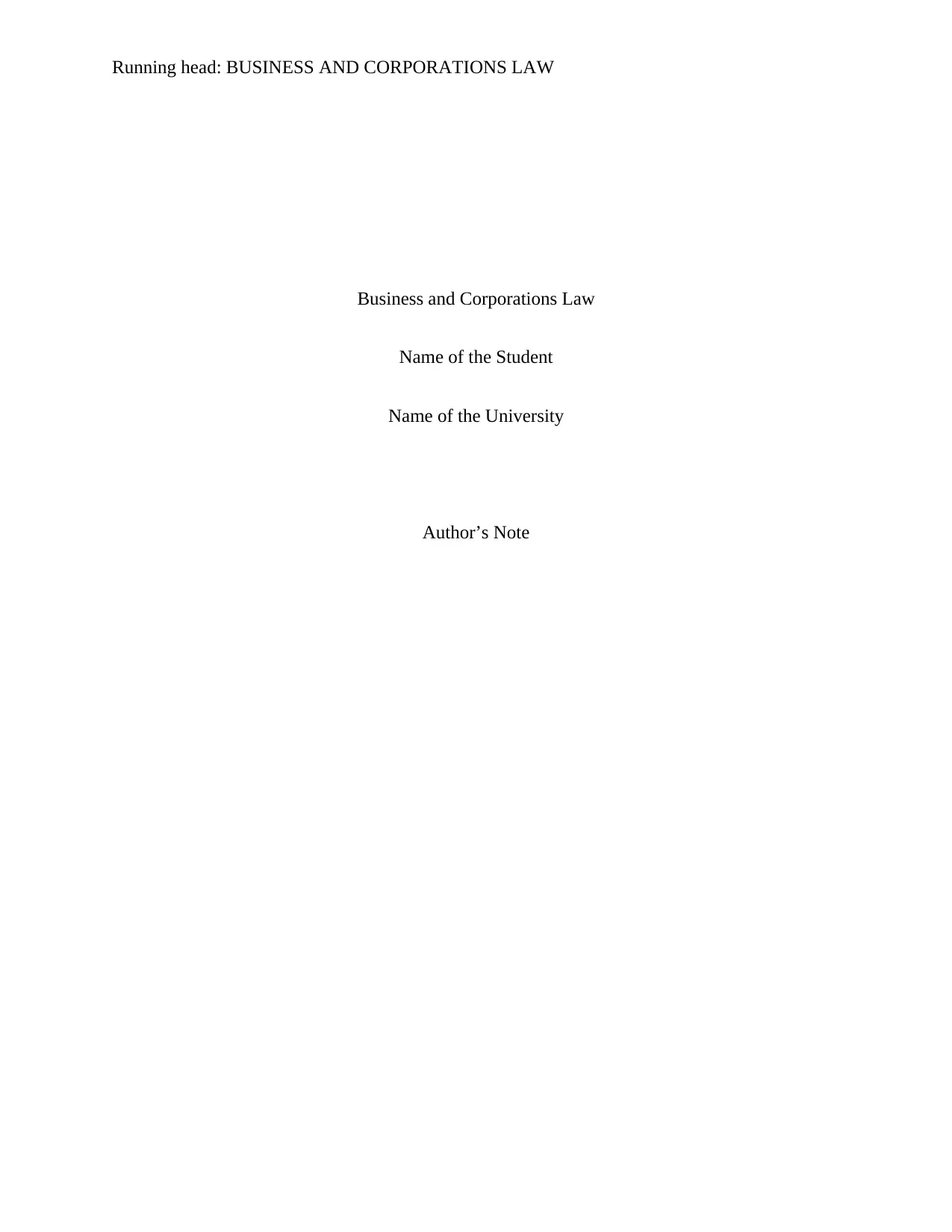
Running head: BUSINESS AND CORPORATIONS LAW
Business and Corporations Law
Name of the Student
Name of the University
Author’s Note
Business and Corporations Law
Name of the Student
Name of the University
Author’s Note
Paraphrase This Document
Need a fresh take? Get an instant paraphrase of this document with our AI Paraphraser
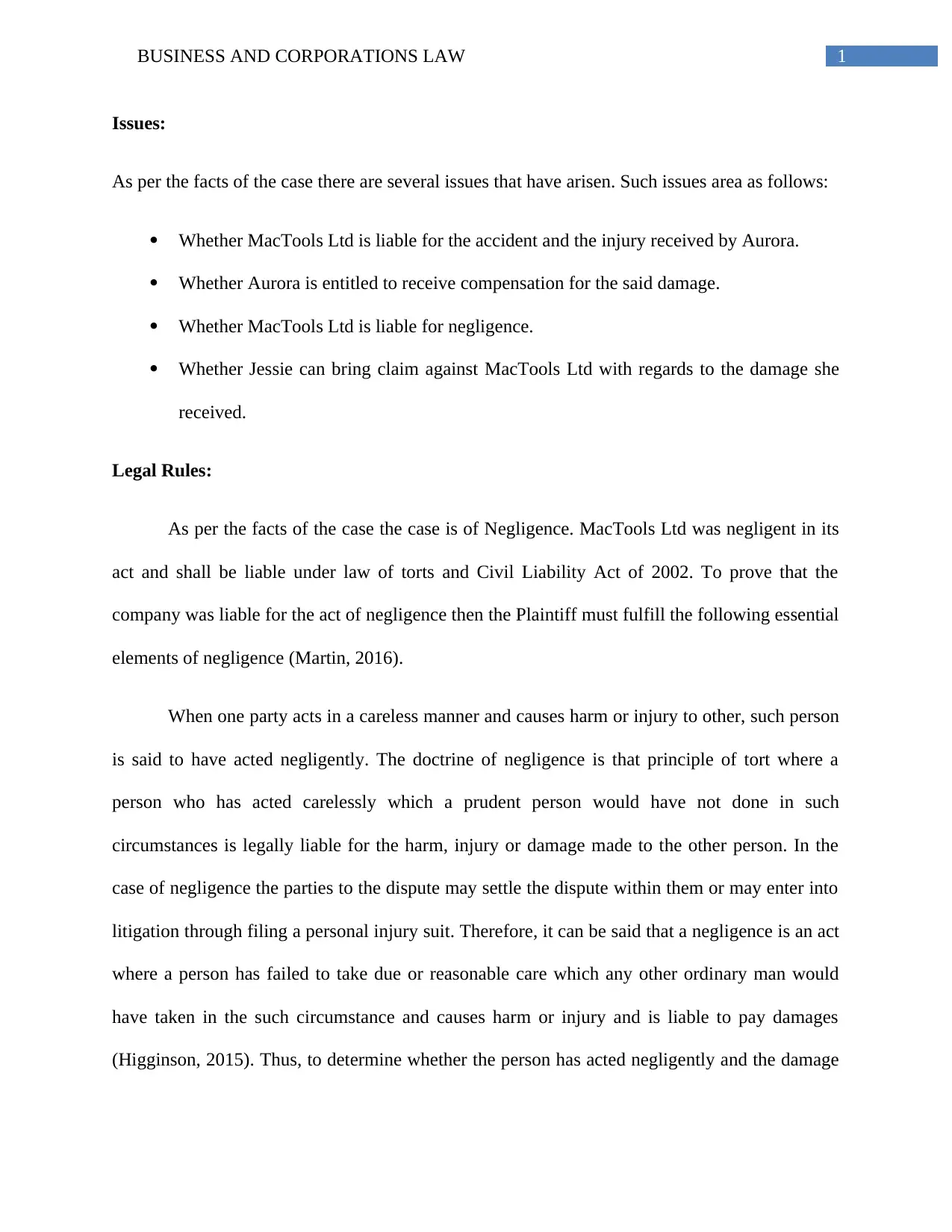
1BUSINESS AND CORPORATIONS LAW
Issues:
As per the facts of the case there are several issues that have arisen. Such issues area as follows:
Whether MacTools Ltd is liable for the accident and the injury received by Aurora.
Whether Aurora is entitled to receive compensation for the said damage.
Whether MacTools Ltd is liable for negligence.
Whether Jessie can bring claim against MacTools Ltd with regards to the damage she
received.
Legal Rules:
As per the facts of the case the case is of Negligence. MacTools Ltd was negligent in its
act and shall be liable under law of torts and Civil Liability Act of 2002. To prove that the
company was liable for the act of negligence then the Plaintiff must fulfill the following essential
elements of negligence (Martin, 2016).
When one party acts in a careless manner and causes harm or injury to other, such person
is said to have acted negligently. The doctrine of negligence is that principle of tort where a
person who has acted carelessly which a prudent person would have not done in such
circumstances is legally liable for the harm, injury or damage made to the other person. In the
case of negligence the parties to the dispute may settle the dispute within them or may enter into
litigation through filing a personal injury suit. Therefore, it can be said that a negligence is an act
where a person has failed to take due or reasonable care which any other ordinary man would
have taken in the such circumstance and causes harm or injury and is liable to pay damages
(Higginson, 2015). Thus, to determine whether the person has acted negligently and the damage
Issues:
As per the facts of the case there are several issues that have arisen. Such issues area as follows:
Whether MacTools Ltd is liable for the accident and the injury received by Aurora.
Whether Aurora is entitled to receive compensation for the said damage.
Whether MacTools Ltd is liable for negligence.
Whether Jessie can bring claim against MacTools Ltd with regards to the damage she
received.
Legal Rules:
As per the facts of the case the case is of Negligence. MacTools Ltd was negligent in its
act and shall be liable under law of torts and Civil Liability Act of 2002. To prove that the
company was liable for the act of negligence then the Plaintiff must fulfill the following essential
elements of negligence (Martin, 2016).
When one party acts in a careless manner and causes harm or injury to other, such person
is said to have acted negligently. The doctrine of negligence is that principle of tort where a
person who has acted carelessly which a prudent person would have not done in such
circumstances is legally liable for the harm, injury or damage made to the other person. In the
case of negligence the parties to the dispute may settle the dispute within them or may enter into
litigation through filing a personal injury suit. Therefore, it can be said that a negligence is an act
where a person has failed to take due or reasonable care which any other ordinary man would
have taken in the such circumstance and causes harm or injury and is liable to pay damages
(Higginson, 2015). Thus, to determine whether the person has acted negligently and the damage
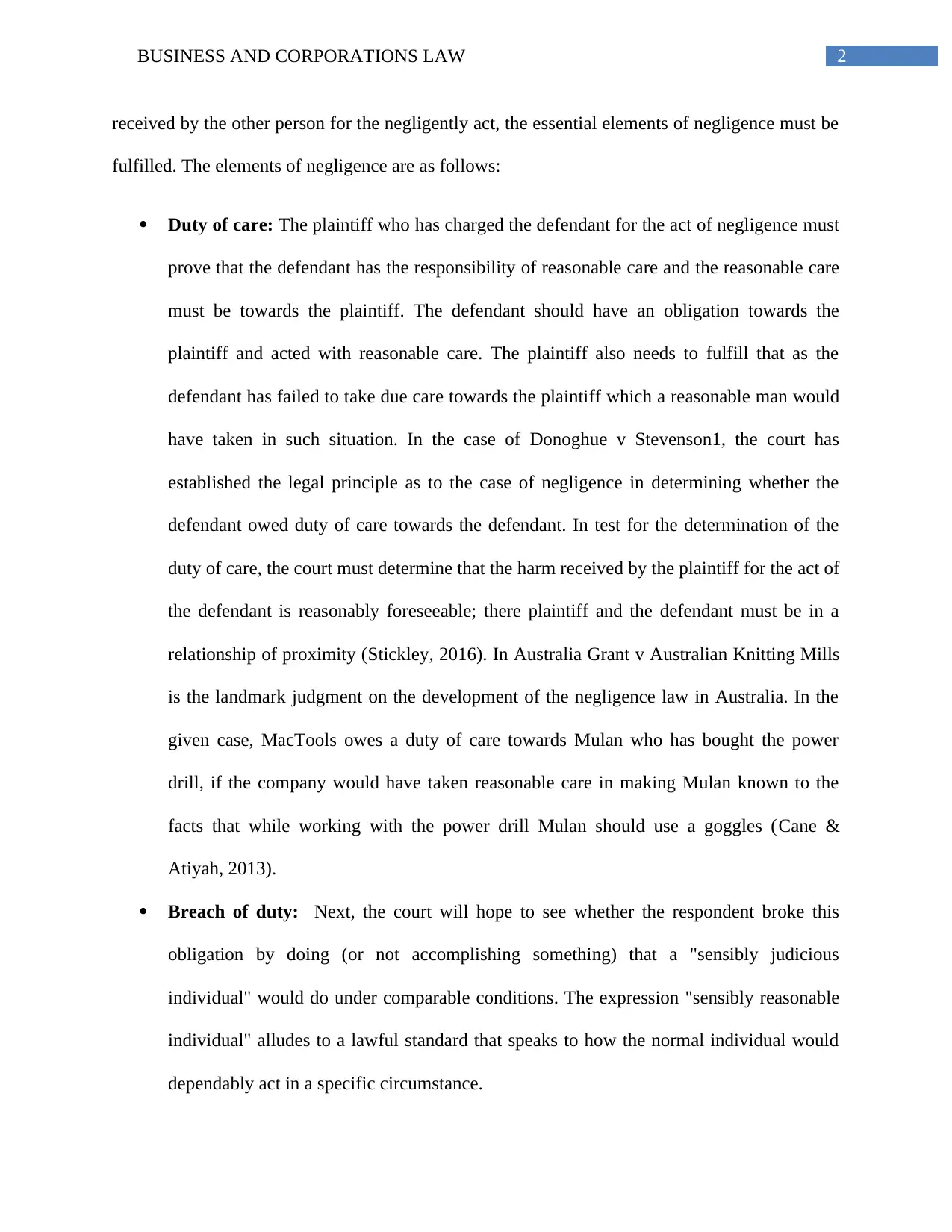
2BUSINESS AND CORPORATIONS LAW
received by the other person for the negligently act, the essential elements of negligence must be
fulfilled. The elements of negligence are as follows:
Duty of care: The plaintiff who has charged the defendant for the act of negligence must
prove that the defendant has the responsibility of reasonable care and the reasonable care
must be towards the plaintiff. The defendant should have an obligation towards the
plaintiff and acted with reasonable care. The plaintiff also needs to fulfill that as the
defendant has failed to take due care towards the plaintiff which a reasonable man would
have taken in such situation. In the case of Donoghue v Stevenson1, the court has
established the legal principle as to the case of negligence in determining whether the
defendant owed duty of care towards the defendant. In test for the determination of the
duty of care, the court must determine that the harm received by the plaintiff for the act of
the defendant is reasonably foreseeable; there plaintiff and the defendant must be in a
relationship of proximity (Stickley, 2016). In Australia Grant v Australian Knitting Mills
is the landmark judgment on the development of the negligence law in Australia. In the
given case, MacTools owes a duty of care towards Mulan who has bought the power
drill, if the company would have taken reasonable care in making Mulan known to the
facts that while working with the power drill Mulan should use a goggles (Cane &
Atiyah, 2013).
Breach of duty: Next, the court will hope to see whether the respondent broke this
obligation by doing (or not accomplishing something) that a "sensibly judicious
individual" would do under comparable conditions. The expression "sensibly reasonable
individual" alludes to a lawful standard that speaks to how the normal individual would
dependably act in a specific circumstance.
received by the other person for the negligently act, the essential elements of negligence must be
fulfilled. The elements of negligence are as follows:
Duty of care: The plaintiff who has charged the defendant for the act of negligence must
prove that the defendant has the responsibility of reasonable care and the reasonable care
must be towards the plaintiff. The defendant should have an obligation towards the
plaintiff and acted with reasonable care. The plaintiff also needs to fulfill that as the
defendant has failed to take due care towards the plaintiff which a reasonable man would
have taken in such situation. In the case of Donoghue v Stevenson1, the court has
established the legal principle as to the case of negligence in determining whether the
defendant owed duty of care towards the defendant. In test for the determination of the
duty of care, the court must determine that the harm received by the plaintiff for the act of
the defendant is reasonably foreseeable; there plaintiff and the defendant must be in a
relationship of proximity (Stickley, 2016). In Australia Grant v Australian Knitting Mills
is the landmark judgment on the development of the negligence law in Australia. In the
given case, MacTools owes a duty of care towards Mulan who has bought the power
drill, if the company would have taken reasonable care in making Mulan known to the
facts that while working with the power drill Mulan should use a goggles (Cane &
Atiyah, 2013).
Breach of duty: Next, the court will hope to see whether the respondent broke this
obligation by doing (or not accomplishing something) that a "sensibly judicious
individual" would do under comparable conditions. The expression "sensibly reasonable
individual" alludes to a lawful standard that speaks to how the normal individual would
dependably act in a specific circumstance.
⊘ This is a preview!⊘
Do you want full access?
Subscribe today to unlock all pages.

Trusted by 1+ million students worldwide
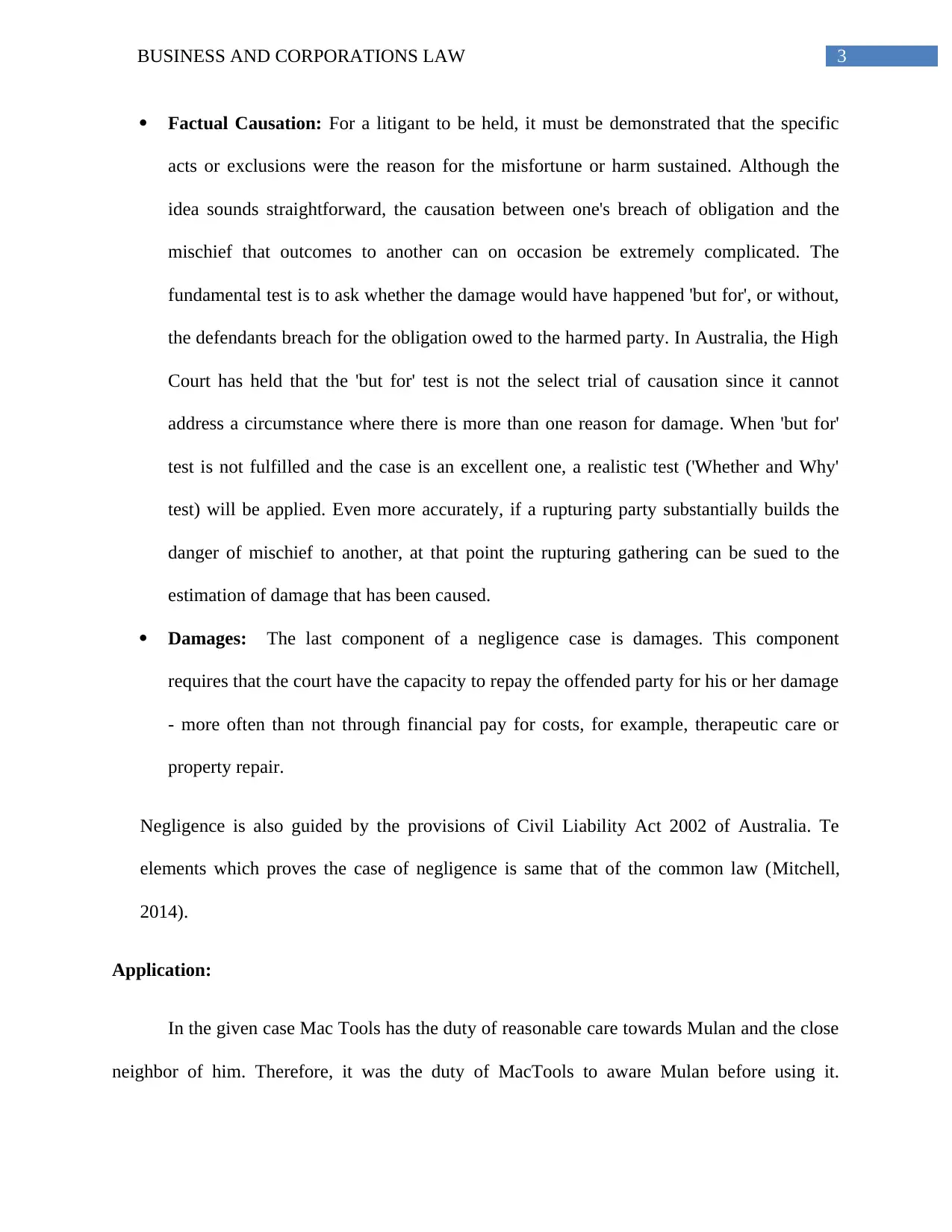
3BUSINESS AND CORPORATIONS LAW
Factual Causation: For a litigant to be held, it must be demonstrated that the specific
acts or exclusions were the reason for the misfortune or harm sustained. Although the
idea sounds straightforward, the causation between one's breach of obligation and the
mischief that outcomes to another can on occasion be extremely complicated. The
fundamental test is to ask whether the damage would have happened 'but for', or without,
the defendants breach for the obligation owed to the harmed party. In Australia, the High
Court has held that the 'but for' test is not the select trial of causation since it cannot
address a circumstance where there is more than one reason for damage. When 'but for'
test is not fulfilled and the case is an excellent one, a realistic test ('Whether and Why'
test) will be applied. Even more accurately, if a rupturing party substantially builds the
danger of mischief to another, at that point the rupturing gathering can be sued to the
estimation of damage that has been caused.
Damages: The last component of a negligence case is damages. This component
requires that the court have the capacity to repay the offended party for his or her damage
- more often than not through financial pay for costs, for example, therapeutic care or
property repair.
Negligence is also guided by the provisions of Civil Liability Act 2002 of Australia. Te
elements which proves the case of negligence is same that of the common law (Mitchell,
2014).
Application:
In the given case Mac Tools has the duty of reasonable care towards Mulan and the close
neighbor of him. Therefore, it was the duty of MacTools to aware Mulan before using it.
Factual Causation: For a litigant to be held, it must be demonstrated that the specific
acts or exclusions were the reason for the misfortune or harm sustained. Although the
idea sounds straightforward, the causation between one's breach of obligation and the
mischief that outcomes to another can on occasion be extremely complicated. The
fundamental test is to ask whether the damage would have happened 'but for', or without,
the defendants breach for the obligation owed to the harmed party. In Australia, the High
Court has held that the 'but for' test is not the select trial of causation since it cannot
address a circumstance where there is more than one reason for damage. When 'but for'
test is not fulfilled and the case is an excellent one, a realistic test ('Whether and Why'
test) will be applied. Even more accurately, if a rupturing party substantially builds the
danger of mischief to another, at that point the rupturing gathering can be sued to the
estimation of damage that has been caused.
Damages: The last component of a negligence case is damages. This component
requires that the court have the capacity to repay the offended party for his or her damage
- more often than not through financial pay for costs, for example, therapeutic care or
property repair.
Negligence is also guided by the provisions of Civil Liability Act 2002 of Australia. Te
elements which proves the case of negligence is same that of the common law (Mitchell,
2014).
Application:
In the given case Mac Tools has the duty of reasonable care towards Mulan and the close
neighbor of him. Therefore, it was the duty of MacTools to aware Mulan before using it.
Paraphrase This Document
Need a fresh take? Get an instant paraphrase of this document with our AI Paraphraser
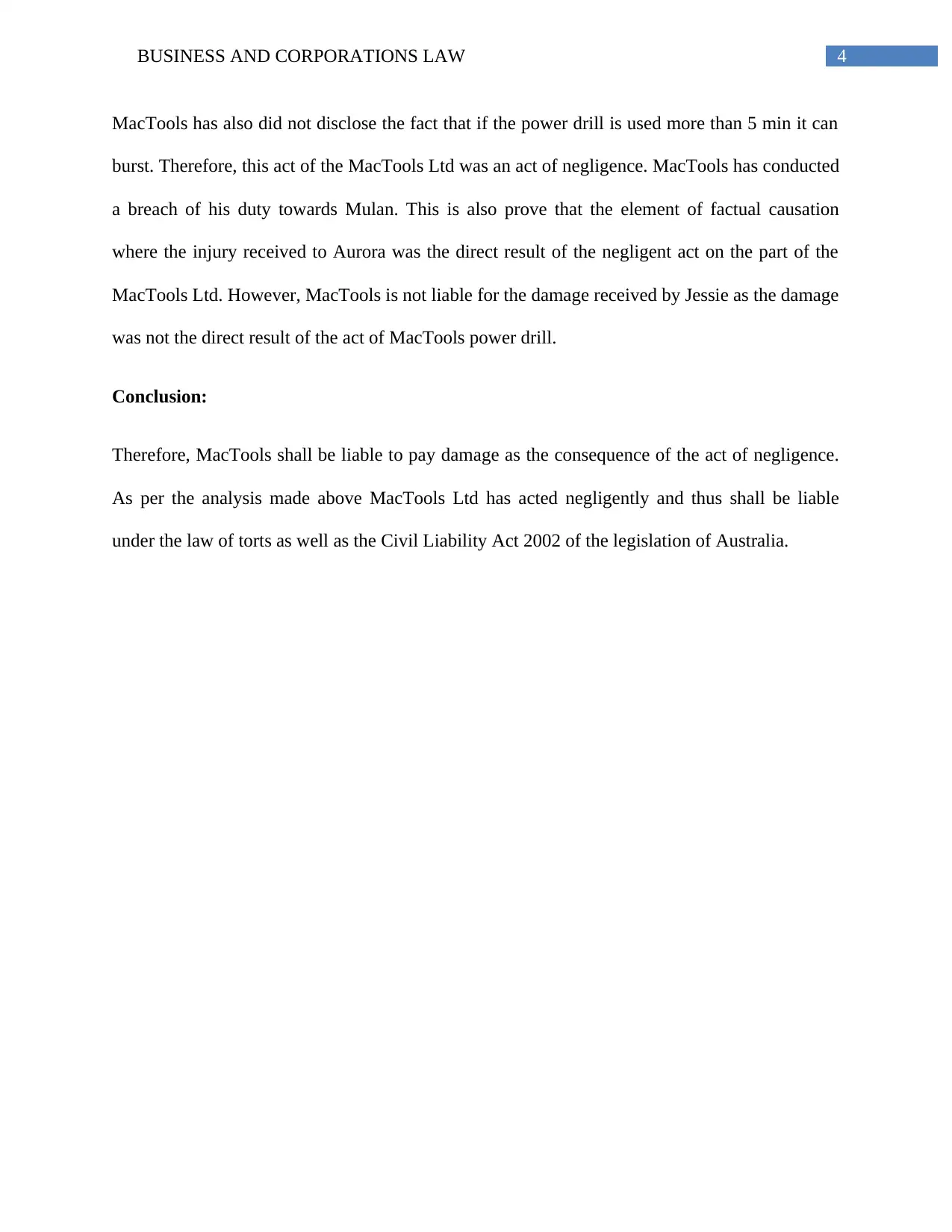
4BUSINESS AND CORPORATIONS LAW
MacTools has also did not disclose the fact that if the power drill is used more than 5 min it can
burst. Therefore, this act of the MacTools Ltd was an act of negligence. MacTools has conducted
a breach of his duty towards Mulan. This is also prove that the element of factual causation
where the injury received to Aurora was the direct result of the negligent act on the part of the
MacTools Ltd. However, MacTools is not liable for the damage received by Jessie as the damage
was not the direct result of the act of MacTools power drill.
Conclusion:
Therefore, MacTools shall be liable to pay damage as the consequence of the act of negligence.
As per the analysis made above MacTools Ltd has acted negligently and thus shall be liable
under the law of torts as well as the Civil Liability Act 2002 of the legislation of Australia.
MacTools has also did not disclose the fact that if the power drill is used more than 5 min it can
burst. Therefore, this act of the MacTools Ltd was an act of negligence. MacTools has conducted
a breach of his duty towards Mulan. This is also prove that the element of factual causation
where the injury received to Aurora was the direct result of the negligent act on the part of the
MacTools Ltd. However, MacTools is not liable for the damage received by Jessie as the damage
was not the direct result of the act of MacTools power drill.
Conclusion:
Therefore, MacTools shall be liable to pay damage as the consequence of the act of negligence.
As per the analysis made above MacTools Ltd has acted negligently and thus shall be liable
under the law of torts as well as the Civil Liability Act 2002 of the legislation of Australia.
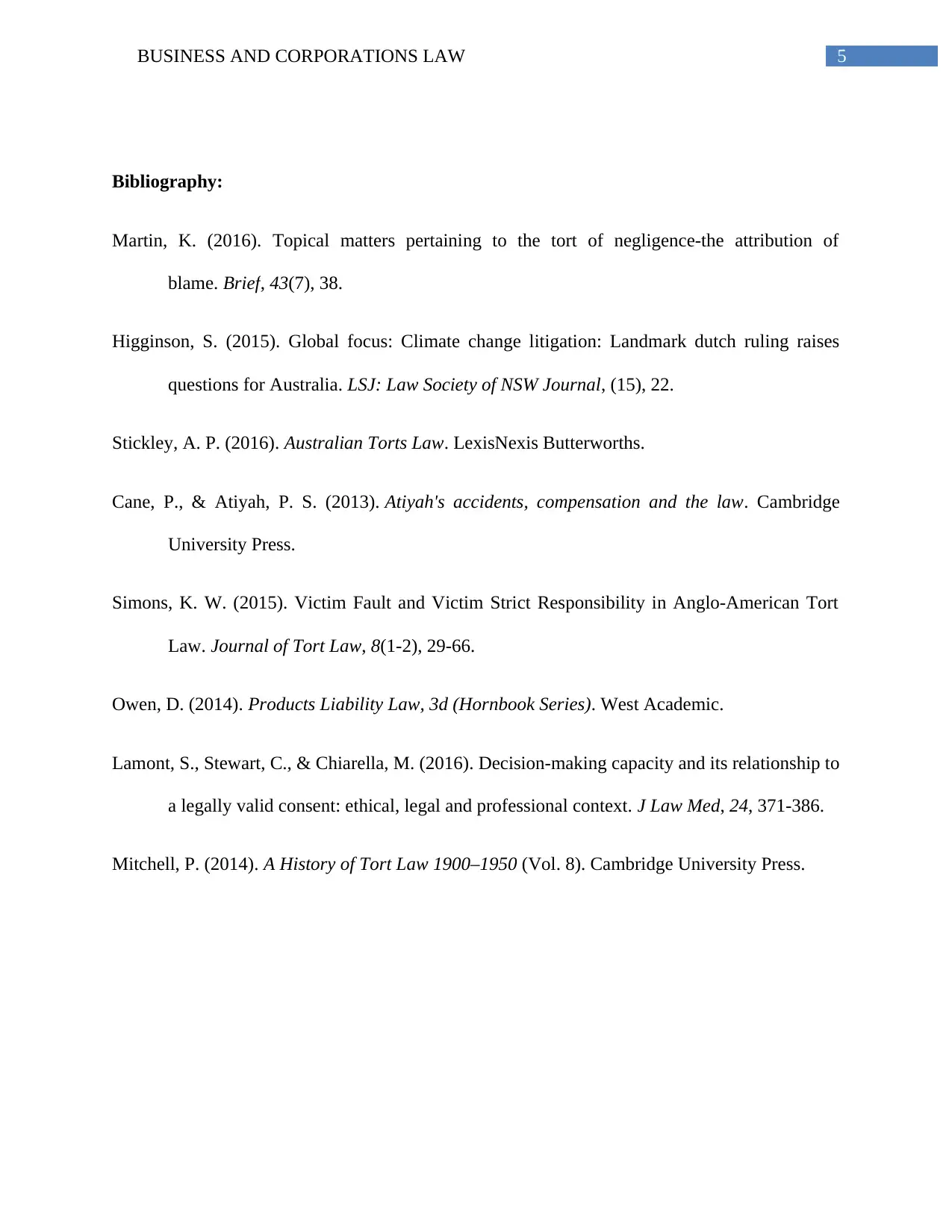
5BUSINESS AND CORPORATIONS LAW
Bibliography:
Martin, K. (2016). Topical matters pertaining to the tort of negligence-the attribution of
blame. Brief, 43(7), 38.
Higginson, S. (2015). Global focus: Climate change litigation: Landmark dutch ruling raises
questions for Australia. LSJ: Law Society of NSW Journal, (15), 22.
Stickley, A. P. (2016). Australian Torts Law. LexisNexis Butterworths.
Cane, P., & Atiyah, P. S. (2013). Atiyah's accidents, compensation and the law. Cambridge
University Press.
Simons, K. W. (2015). Victim Fault and Victim Strict Responsibility in Anglo-American Tort
Law. Journal of Tort Law, 8(1-2), 29-66.
Owen, D. (2014). Products Liability Law, 3d (Hornbook Series). West Academic.
Lamont, S., Stewart, C., & Chiarella, M. (2016). Decision-making capacity and its relationship to
a legally valid consent: ethical, legal and professional context. J Law Med, 24, 371-386.
Mitchell, P. (2014). A History of Tort Law 1900–1950 (Vol. 8). Cambridge University Press.
Bibliography:
Martin, K. (2016). Topical matters pertaining to the tort of negligence-the attribution of
blame. Brief, 43(7), 38.
Higginson, S. (2015). Global focus: Climate change litigation: Landmark dutch ruling raises
questions for Australia. LSJ: Law Society of NSW Journal, (15), 22.
Stickley, A. P. (2016). Australian Torts Law. LexisNexis Butterworths.
Cane, P., & Atiyah, P. S. (2013). Atiyah's accidents, compensation and the law. Cambridge
University Press.
Simons, K. W. (2015). Victim Fault and Victim Strict Responsibility in Anglo-American Tort
Law. Journal of Tort Law, 8(1-2), 29-66.
Owen, D. (2014). Products Liability Law, 3d (Hornbook Series). West Academic.
Lamont, S., Stewart, C., & Chiarella, M. (2016). Decision-making capacity and its relationship to
a legally valid consent: ethical, legal and professional context. J Law Med, 24, 371-386.
Mitchell, P. (2014). A History of Tort Law 1900–1950 (Vol. 8). Cambridge University Press.
⊘ This is a preview!⊘
Do you want full access?
Subscribe today to unlock all pages.

Trusted by 1+ million students worldwide
1 out of 6
Related Documents
Your All-in-One AI-Powered Toolkit for Academic Success.
+13062052269
info@desklib.com
Available 24*7 on WhatsApp / Email
![[object Object]](/_next/static/media/star-bottom.7253800d.svg)
Unlock your academic potential
Copyright © 2020–2025 A2Z Services. All Rights Reserved. Developed and managed by ZUCOL.





